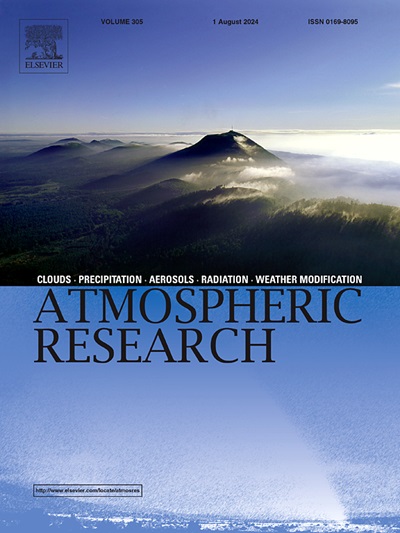Effects of the estimated inversion strength and aerosols on monthly variations of subtropical marine stratocumulus to the west of Africa
IF 4.5
2区 地球科学
Q1 METEOROLOGY & ATMOSPHERIC SCIENCES
引用次数: 0
Abstract
Satellite and reanalysis data over the 2003–2022 period are used to study how the monthly variations of marine stratocumulus (MSc) to the west of Canary Islands and Namibia are influenced by thermodynamic variables and aerosols. Although the estimated inversion strength (EIS) has been thought to be the main predictor of low-cloud cover (LCC), the seasonal cycles of EIS and LCC differ significantly in the Canary MSc region. In linear regression models, adding dust aerosol (DA) optical depth as a predictor improves the prediction of LCC across all seasons and almost everywhere in the region compared to using EIS alone. In boreal summer, large amount of DAs are transported from the Sahara to the Canary MSc region. Analysis of the regression models shows that DAs contribute more than EIS to the Canary summer LCC maximum, reducing the error by up to 11 %. Biomass-burning aerosols (BBAs) also improve the prediction of LCC in the Canary MSc region, but less so than DAs, suggesting that BBAs are less effective as cloud condensation nucleii. Other known thermodynamic predictors of LCC (sea surface temperature, horizontal surface temperature advection, near-surface wind speed, and free-tropospheric relative humidity and vertical velocity) also improve the prediction, but much less effectively than the aerosols. In the Namibia MSc region, there are virtually no DAs but BBAs are abundant. There, EIS alone captures well the seasonal cycle of LCC. In this region, the effect of BBAs on LCC is hidden behind that of EIS, potentially because BBA optical depth and EIS coincidentally have similar seasonal cycles.
估计逆温强度和气溶胶对非洲西部副热带海洋层积云月变化的影响
利用2003-2022年期间的卫星和再分析数据,研究了加那利群岛和纳米比亚以西海洋层积云(MSc)的月变化如何受到热力学变量和气溶胶的影响。虽然估计的逆温强度(EIS)一直被认为是低云量(LCC)的主要预测因子,但在金丝雀MSc地区,EIS和LCC的季节周期存在显著差异。在线性回归模型中,与单独使用EIS相比,将尘埃气溶胶(DA)光学深度作为预测因子可以提高对所有季节和几乎所有地区LCC的预测。在北方夏季,大量的DAs从撒哈拉沙漠运输到加那利地中海地区。回归模型分析表明,DAs比EIS对金丝雀夏季LCC最大值的贡献更大,误差降低了11%。生物质燃烧气溶胶(BBAs)也改善了金丝雀MSc地区LCC的预测,但不如DAs,表明BBAs作为云凝结核的效果较差。其他已知的LCC的热力学预测因子(海表温度、水平表面温度平流、近地面风速、自由对流层相对湿度和垂直速度)也提高了预测效果,但效果远不如气溶胶。在纳米比亚的MSc区域,几乎没有da,但ba很丰富。在那里,仅EIS就能很好地捕捉到低成本成本的季节周期。在该地区,BBA对LCC的影响隐藏在EIS的影响之后,可能是因为BBA光学深度和EIS恰好具有相似的季节周期。
本文章由计算机程序翻译,如有差异,请以英文原文为准。
求助全文
约1分钟内获得全文
求助全文
来源期刊

Atmospheric Research
地学-气象与大气科学
CiteScore
9.40
自引率
10.90%
发文量
460
审稿时长
47 days
期刊介绍:
The journal publishes scientific papers (research papers, review articles, letters and notes) dealing with the part of the atmosphere where meteorological events occur. Attention is given to all processes extending from the earth surface to the tropopause, but special emphasis continues to be devoted to the physics of clouds, mesoscale meteorology and air pollution, i.e. atmospheric aerosols; microphysical processes; cloud dynamics and thermodynamics; numerical simulation, climatology, climate change and weather modification.
 求助内容:
求助内容: 应助结果提醒方式:
应助结果提醒方式:


